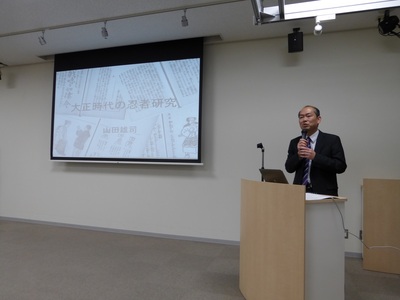1st "The Ninja Research During the Taisho Period" (First half)
The Ninja Research During the Taisho Period
Yamada, Yuji
During the Taisho Period, directly following the Meiji Restoration, Japan continued to be heavily influenced by Western culture, and it's rapid modernisation instilled in many people a deep interest in the various "sciences". This included a great interest in verifying (scientifically) aspects such as Reikon (a native Japanese soul-spirit), as well as hypnosis, and what might be called psychic abilities.
The existence of ESP (extra-sensory powers), such as clairvoyance, telepathy, psychic photography, and extra-sensory perception, all started to become a focus of many people in Japan. Even today, skills such as Reijutsu (an affinity or sensitivity to subtle energies within people or objects, part of the basis of the practice of Reiki) hold a lot of fascination in the island nation. At the same time (the Taisho Period), social conflict and stress began to come to the surface, due in part to the rapid growth and adoption of capitalism. To provide a counter to this growth, there developed a movement to re-evaluate the spiritual traditions of the culture, aiming to resist the more materialistic ideals taking hold.
With regards to Ninjutsu, the popular understanding of the concept also underwent a great re-energising. During the Edo Period, the Ninjutsu Tsukai (a practitioner of Ninjutsu, what might be referred to as a "ninja" today) was seen largely as a magician, someone who could disappear at will, and could cast various spells to achieve their aims. In the Taisho Era, this image had a resurgence… led in the popular media by publications from Tatsukawa Bunko Editions' companies novels based around the character of "Sasuke Sarutobi" (a popular character often shown as a mischievous young person), and by the movie "Jiraiya", directed by Onoe Matsunosuke. As a result, Ninjutsu grew in popularity, particularly among children, to the point that it was believed to be a cause of disobedience towards the adults.
There then began one of the first major attempts to scientifically understand or explain the stories of Ninjutsu, attempting to interpret both Ninjutsu and Ninjutsu Tsukai/Ninja in a rational way. One such person who attempted to come to a more rational understanding was Gingetsu Ito (1871-1944). Gingetsu Ito wrote a book, "The Essential Points of Ninjutsu" (published by Bukyo Sekaisha, 1917), in addition to a number of other books on the topic. Gingetsu Ito focused his analysis on texts such as the Shoninki, and defined Ninjutsu as "a process of performing a task while overcoming a range of difficulties or dangers, with an overall purpose being the skill of spying. Ninja, therefore, include skills that combine physical, psychological, and strategic understanding in everything they do."
A number of Ninjutsu books have been published by other people during the Taisho Era, however they are primarily written by people who had formed their own "modern Ninjutsu" groups, and were largely based in these newly formed approaches, rather than actual historical accounts. During the Russo-Japanese War, a master of Ninjutsu, Nogi Maresuke, made the observation that "Ninjutsu is a patient application of removing the unnecessary (patient surgery on a political level)", and claimed that the practice of Ninjutsu was important for the development of Yamato-damashii (the Japanese spirit, as well as the values of the Japanese culture).
